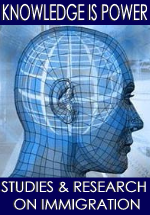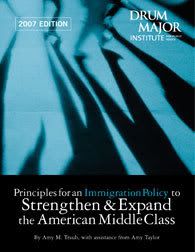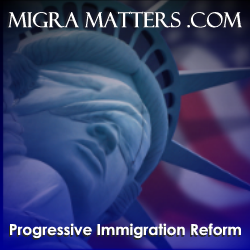MPI releases data on merit based point systems for immigration
 The Migration Policy Institute, a non-profit think tanks that studies global migration and refugee policies , has released a report that sheds some additional light on the proposed "merit system" contained in the compromise immigration reform legislation now being debated in the Senate.
The Migration Policy Institute, a non-profit think tanks that studies global migration and refugee policies , has released a report that sheds some additional light on the proposed "merit system" contained in the compromise immigration reform legislation now being debated in the Senate.
The report, authored by the Institute's President, Demetrios Papademetriou, who is viewed as a leading expert on the use of point systems internationally and has advised more than 20 countries on their immigration policies, looks at how point systems work in general, and more importantly examines recent US immigration trends to see how various immigrant groups from around the world would be effected by the new proposal.
The MPI backgrounder titled, "Proposed Points System and Its Likely Impact on Prospective Immigrants", looks at the current demographic data on the foreign born in the United States as it relates to the immigrant selection criteria expected to be part of "merit system" proposal. These include age, educational attainment, occupation, English proficiency, and labor force participation.
In the report, Papademetriou sets four criteria by which to judge the effectiveness of any point based system:Things To Watch For
At the end of the day, points selection systems are a bit like government budgets: They tell the reader where a government and a society’s priorities lie. The following are the things to watch for in that regard:1. The “pass mark,” that is, the points total one would have to earn in order to be admitted to the United States. Setting a high pass mark would likely disqualify applicants with fewer formal skills and less education but skills which may nonetheless be essential. If the pass mark is allowed to fluctuate (the term of art is “float”) those with the highest formal qualifications and degrees will crowd out all others.
2. The overall number of visas allocated to points selected immigrants. The supply of visas would always be lower than the demand for them by people eager to come to the United States. However, if the number of visas allocated and the difficultly of obtaining sufficient points for entry are not aligned, and not all who earn enough points to qualify for visas can obtain them, the immigration system would once again become clogged by large and growing backlogs.
3. The internal distribution of points—both the categories chosen but, more importantly, the weight distribution within each category. Allocating many points for education but few for employment in high-demand occupations such as carpenters and home health aides, for example, would skew the immigration system toward the high-skilled. Allocating many points for age (youth) or for participation in a proposed apprenticeship program but fewer for employment in a specialty occupation requiring a college degree would skew immigration toward the low skilled. Small changes in the allocation of points could have very large ramifications for the composition of immigrants granted entry through a merit-based system.
4. Mechanisms for revising or adjusting the system. Many of the current problems in the US immigration system – visa supply being out of line with labor force supply and demand, high rates of illegal immigration, persistent backlogs, and systemic delays all have roots in the inflexibility of the current immigration system. Revisions to the immigration system can happen more quickly and with less national anguish if flexibility is built into the statute and Congress does not need to revisit immigration law on a regular basis in order to update laws to match constantly changing social, economic, and demographic realities. The qualifications desired of immigrants in 2009 may not be the qualifications desired in 2012 or 2020, so the ability to review the points system and revise as needed/desired would become crucial.
Proposed Points System and Its Likely Impact on Prospective Immigrants, Immigration Policy Institute
In light of MPI's criteria for effective point systems, we must look at exactly what has been proposes in the current legislation.
The proposed merit system is intended to replace the current "employment based" system for allotting green cards which has relied on employer sponsorship as well as other criteria for determining eligibility. Under the proposed legislation the current number of employment based green cards of 140,000 would be replaced as follows:Merit worldwide ceiling: Sets 3 different worldwide ceiling levels.
First five fiscal years post-enactment will be set at the level made available during FY05 ( 247K).
Next 3 or 4 fiscal years (until first undocumented Z visas can start adjusting), sets level at 140K
Once undocumented start adjusting (outside the worldwide ceilings), sets level at 380K
These future green cards would then be issued using the following merit based point criteria:Section 502. Merit-Based Evaluation System for Immigrants
Eliminates employment preference categories 1, 2, and 3 and replaces it with a merit-based preference system.
Eliminates the labor certification process. Maintains the special immigrant and EB-5 categories but cuts their numbers (total of 7,000 available annually).
Merit points are initially assigned as follows with a total of 100 points that could be earned:Employment: 47 maximum total points can be earned for:
Education: 28 maximum total points can be earned for:
English/Civics: 15 total points can be earned for:
Extended Family: for those with total of 55 or above in above categories, 10 total points can be earned for:
In addition, the following allocation has been set aside for the new Z visa category:Agricultural Work: 25 total points can be earned for:
U.S. Employment: 15 total points can be earned for:
Home Ownership: 5 total points can be earned for:
Medical Insurance: 5 points total can be earned for:
Gives DHS authority to establish regulations regarding petition process for merit-based system and creates a standing commission on immigration and labor markets for evaluating the relative weighting and selection criteria included in the point system. Petitions that have not been granted within a 3 year period are deemed denied.
Section-by-Section Summary of the Senate “Grand Bargain” Bill , AILA
Given the details as presented thus far in the legislation it has obviously not met MPI's first test. The legislation makes no mention whatsoever of a "pass mark" or how these points are to be evaluated. Are the top 140,000 applicants in a given fiscal year to be accepted? Is there a minimum "grade" that must be attained? Will the "pass mark" float? These are all questions that should be answered in the legislation before any serious consideration of this proposal can be made.
So just how will this merit system effect future immigration patterns?
MPI looked at the demographic data from recent immigration and found that the merit system as written will favor certain immigrant groups while making it much more dificult for others to enter. Some Initial Observations From The Data
The question everyone is trying to answer can be posed most simply (and directly) as follows: In applying the new admissions’ criteria to those who entered during the past 15 years, what would the impacts be on groups with different skill and education mixes?
Immigrants from many Asian countries would likely fare well under a points system as it is currently being described.
• Two-fifths of all recent Asian immigrants to the United States (i.e., those who entered since 1990), and at least one-third from the top five Asian sending countries are in the age range (25-39) that would garner points under the proposed system.
• Over half of recent immigrants from China, the Philippines, and Korea, and 76 percent from India have a bachelor’s or higher degree. If we add those with associates’ degrees, the strong educational advantage of a points system for Asians widens further. (Vietnam is the only significant exception in this regard.)
• The majority of recent immigrants from the Philippines and India report speaking English “very well” and would fare well under a points system.
• About half of recent immigrants from India work in IT, science and engineering, or healthcare occupations, while another 20 percent work in other professional occupations. About one-quarter of recent immigrants from the Philippines work in healthcare occupations. Employment within each of these occupations is preferred under the proposed points system. About one-quarter of recent immigrants from China work in science, technology, engineering, and mathematics occupations, while another quarter work in other professional occupations.
Immigrants from Latin American countries will likely face more difficulties in obtaining entry through the points system, depending on how categories are weighted. Age and occupational characteristics may benefit immigrants from this area, while formal educational attainment and English ability may become barriers.
• More than two-fifths of recent Central American/Caribbean and South American immigrants are in the preferred age range of 25-39. Forty-eight percent of recent Mexican immigrants and 53 percent of recent Salvadoran immigrants are 25 to 39 years of age, as are 48 percent of recent immigrants from both Brazil and Ecuador.
• The vast majority of recent immigrants from South America have at least a high school diploma, and 31 percent have a bachelor’s or higher degree. However, just 45 percent of recent immigrants from Central America and the Caribbean have a high school diploma or higher. Cuban and Dominican immigrants are exceptions in this regard, with high relative rates of college education compared to other countries in the region.
• The vast majority (about 80 percent) of Central American/Caribbean recent immigrants and a strong majority (about 60 percent) of South American recent immigrants lack English proficiency. The trend holds true for the top five sending countries from both areas, with the exception of immigrants from Venezuela, 44 percent of whom report that they are proficient in English. Only 15 percent of recent Mexican immigrants are proficient in English.
• The occupations common among Central American and Caribbean immigrants may earn points under the “high demand” occupation category. Most of the occupations expected to experience the highest job growth over the next ten years require only on-the-job training. The majority of Central American/Caribbean immigrants work in such lowerskill, high-growth occupations as construction, extraction, transportation, service, manufacturing, and installation. Extremely small shares of immigrants from the largest sending countries in the region work in preferred science, engineering, or health occupations.
• The occupations of South American immigrants follow a similar trend to those for Central American and Caribbean immigrants, though slightly higher shares of South Americans work in mid-level or high-skill occupations.
While the United States has received relatively few immigrants from Africa, those who have entered have language, age, and educational characteristics that could help them earn points for entry.
• As with the other world regions examined, about two-fifths of recent African immigrants fall in the preferred age range of 25-39.
• Recent African immigrants tend to be well educated. Thirty-eight percent of all recent African immigrants have a bachelor’s or higher degree, and fully two-thirds have some college education. Those from Nigeria, Egypt, and South Africa have the highest levels of educational attainment among the top African sending countries: over half from each have a bachelor’s or higher degree. Fewer Ethiopian immigrants have bachelor’s degrees – under a quarter – but 60 percent do have some college education.
• English proficiency tends to vary by country but is high overall. Eighty-seven percent of recent Nigerian immigrants, and 96 percent of South African immigrants are English proficient, while just over half from Ethiopia and Egypt are English proficient. Looking at all recent African immigrants, two-thirds are English proficient.
• About 15 percent of African immigrants work in preferred health occupations (27 percent of Nigerian immigrants do so) while the great majority of African immigrants work in low-skill occupations. Very small shares work in science or engineering occupations, though those from South Africa have higher rates of professional occupations than immigrants from other parts of Africa.
Proposed Points System and Its Likely Impact on Prospective Immigrants, Immigration Policy Institute
While there will certainly be intense debate over this hotly contested issue in Washington, we can only hope that those trying to craft this legislation do so not solely with an eye to the next election cycle, or the local polls in their state or district... but with the best interests of both the American people and those who will be future Americans in mind.
Related:
Annual Immigration to the United States: The Real Numbers, MPI, May, 2007
Selecting Economic Stream Immigrants through Points Systems, MPI, May, 2007
A "high demand occupation" as defined in the legislation is one listed on the Bureau of Labor Statistics top 30 projected 10 year growth occupations: BLS Occupations with the largest job growth, 2004–14
41-2031Retail salesperson
29-111 Registered nurses
25-1000 Postsecondary teachers
43-4051 Customer service representative
37-2011 Janitors and cleaners, except maids and housekeeping cleaners
35-3031 Waiters and waitresses
35-3021 Combined food preparation and serving workers, including fast food
31-1011 Home health aids
31-1012 Nursing aids, orderlies and attendants
11-1021 General and operations managers experienced
39-9021 Personal and home aides
25-2021 Elementary school teachers, except special education
13-2011 Accountants and auditors
43-9061 Office clerks, general
53-3032 Laborers and freight stock, and material movers, hand
43-4171 Receptionists and information clerks
37-3011 Landscaping and groundskeeping workers
53-3032 Truck drivers, heavy and tractor trailer
15-1031 Computer software engineers, applications
49-9042 Maintenance and repair workers, general
31-9092 Medical assistants
43-6011 Executive secretaries and administrative assistants
41-4012 Sales representatives, wholesale and manufacturing, except technical and scientific products
47-2031 Carpenters
25-9041 Teachers assistants
39-9011 Child care workers
35-2021 food preparation workers
37-2012 Maids and housekeeping cleaners
53-3033 Truck driver light or delivery services
15-1051 Computer systems analysts
Occupational employment
projections to 2014, table #3 Bureau of Labor Statistics















 When talk turns to immigration and immigration reform more often than not the discussion will revolve around the border states or California with its large Latino population, or even the southeast where the recent influx of new immigrants has sparked backlash and controversy. But rarely do people think of traditional immigrant gateways like New York. Yet, every year New York is in the top three states for the number of foreign born residents both legal and illegal, and as anyone with even a cursory knowledge of the state can figure out, the bulk of those immigrants live in and around the NYC area.
When talk turns to immigration and immigration reform more often than not the discussion will revolve around the border states or California with its large Latino population, or even the southeast where the recent influx of new immigrants has sparked backlash and controversy. But rarely do people think of traditional immigrant gateways like New York. Yet, every year New York is in the top three states for the number of foreign born residents both legal and illegal, and as anyone with even a cursory knowledge of the state can figure out, the bulk of those immigrants live in and around the NYC area. One often wonders when listening to various politicians pontificate about immigration reform, exactly what information they are basing their policies and positions on. Given the conflicting information coming from both partisan and academic sources, it would appear a daunting task to get reliable, non-biased information about the issue. A recently released report from the Congressional Research Service provides a unique glimpse into what our legislators are reading about the issue.
One often wonders when listening to various politicians pontificate about immigration reform, exactly what information they are basing their policies and positions on. Given the conflicting information coming from both partisan and academic sources, it would appear a daunting task to get reliable, non-biased information about the issue. A recently released report from the Congressional Research Service provides a unique glimpse into what our legislators are reading about the issue. 
 There is no more divisive issue for advocates of progressive immigration reform than the policy of temporary guest workers. As a cornerstone the President's proposed immigration policy, it's been viewed with intense suspicion by many on the left. Some immigration rights advocates, such as Cecilia Muñoz, head of National Council of La Raza see Bush's guest worker program as the best hope to allow future immigrants to enter the country legally and eventually be put on a path to citizenship. Other's see it as dangerous policy, ripe with opportunities for abuse.
There is no more divisive issue for advocates of progressive immigration reform than the policy of temporary guest workers. As a cornerstone the President's proposed immigration policy, it's been viewed with intense suspicion by many on the left. Some immigration rights advocates, such as Cecilia Muñoz, head of National Council of La Raza see Bush's guest worker program as the best hope to allow future immigrants to enter the country legally and eventually be put on a path to citizenship. Other's see it as dangerous policy, ripe with opportunities for abuse. The
The 
















